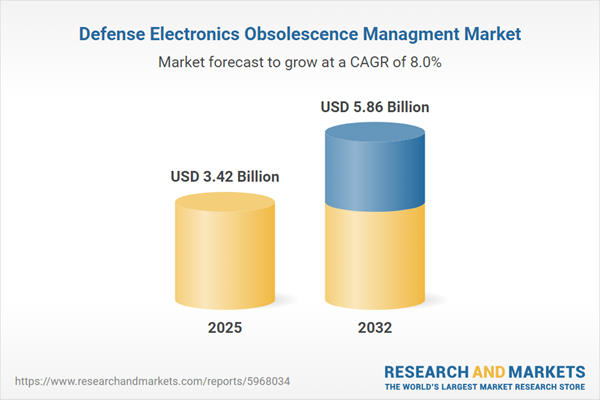Speak directly to the analyst to clarify any post sales queries you may have.
The Defense Electronics Obsolescence Management Market provides senior defense decision-makers with strategies to sustain electronic systems and proactively reduce operational and regulatory risks as mission demands evolve. This report delivers actionable insights for reliable system performance, ensuring adaptability and resilience amid the shifting defense electronics landscape.
Market Snapshot: Defense Electronics Obsolescence Management Market Overview
The global Defense Electronics Obsolescence Management Market is positioned for steady expansion, anticipated to grow from USD 3.17 billion in 2024 to USD 3.42 billion in 2025, and is forecasted to reach USD 5.86 billion by 2032. This sustained growth is propelled by the urgent need for defense stakeholders to connect legacy platforms with modern technologies, facilitating digital transformation throughout asset lifecycles. Organizations are moving toward modular hardware and digital engineering to streamline upgrades, achieve compliance, and optimize mission-critical reliability. Regulatory shifts worldwide underscore the necessity for advanced lifecycle management and digital transition capabilities in both established and emerging defense environments.
Scope & Segmentation
- Solution Type: Covers component procurement, engineering improvements, asset lifecycle extension programs, software management, and stringent quality assurance. Employs advanced analytics, including electrical and X-ray assessment, to elevate compliance and system reliability.
- Component Type: Involves core elements such as connectors, cables, integrated circuits, passive signal components, printed circuit boards, sensors, and actuators. Each maintains system integrity and streamlines upgrades or repairs.
- Platform: Serves fixed and rotary-wing aircraft, armored vehicles, naval ships, submarines, and space-based assets. Ensures effective modernization, operational readiness, and global mission capability across air, land, sea, and space domains.
- End User: Encompasses defense contractors overseeing international supply networks, as well as military organizations focused on extending platforms’ operational life, optimizing resources, and adapting to dynamic conditions.
- Regional Coverage: Includes the Americas, Europe, Middle East & Africa, and Asia-Pacific. Regional markets such as the United States, France, Germany, China, Japan, Australia, and India face unique regulatory and sourcing challenges shaping local obsolescence strategies.
- Key Players: Features companies like Lockheed Martin, Raytheon Technologies, Northrop Grumman, BAE Systems, General Dynamics, Boeing, L3Harris, Thales Group, Leonardo S.p.A., and Airbus. Collaboration among these leaders establishes benchmarks and promotes uniformity in lifecycle management globally.
Key Takeaways for Senior Decision-Makers
- Aligning obsolescence management with digital transformation strengthens operational reliability, ensuring defense systems remain effective as demands evolve.
- Adoption of digital engineering and simulation streamlines integration between existing infrastructure and new technologies, supporting a diverse range of defense objectives.
- Building resilient supplier ecosystems—through near-shoring and additive manufacturing—decreases risk of supply chain interruptions, preserving material flow during global instability.
- Incorporating analytics and artificial intelligence optimizes detection of component aging, enhancing preventive maintenance and resource utilization.
- Strategic collaboration between manufacturers and end users increases agility to address changes in procurement processes and regulatory landscape.
- Flexible procurement and contracting models aid compliance with evolving standards and foster long-term operational continuity.
Tariff Impact: Navigating Regulatory Pressures in Obsolescence Strategies
Recent trade tariffs on semiconductors and electronic assemblies are reshaping defense electronics supply chains. In response, organizations are pursuing near-shoring options, diversifying procurement, and adapting sourcing practices to address rapidly changing trade rules. Regular reviews of local manufacturing capabilities and strong supplier relationships have become essential for maintaining both compliance and continuous supply in increasingly regulated environments.
Methodology & Data Sources
This market analysis combines direct insights from procurement leaders, engineering professionals, and regulatory reviews. The methodology integrates continuous supplier performance tracking, real-time procurement monitoring, and validation of sector trends, supporting risk-based recommendations and grounded guidance for obsolescence management.
Why This Report Matters
- Enables defense leaders to strategically address obsolescence, enhancing system longevity and mission-readiness under changing requirements.
- Provides flexible frameworks to adapt to shifts in procurement and compliance, supporting sustained reliability and schedule adherence across defense supply chains.
- Equips executives with practical guidance for managing technology transitions, ensuring continued competitiveness in the evolving defense electronics environment.
Conclusion
Effective management of electronics obsolescence supports continuous mission performance and system reliability. Leaders who invest in agile procurement and emerging technologies secure operational agility and resilience in a dynamic defense sector.
Additional Product Information:
- Purchase of this report includes 1 year online access with quarterly updates.
- This report can be updated on request. Please contact our Customer Experience team using the Ask a Question widget on our website.
Table of Contents
3. Executive Summary
4. Market Overview
7. Cumulative Impact of Artificial Intelligence 2025
Companies Mentioned
The companies profiled in this Defense Electronics Obsolescence Managment market report include:- Lockheed Martin Corporation
- Raytheon Technologies Corporation
- Northrop Grumman Corporation
- BAE Systems plc
- General Dynamics Corporation
- The Boeing Company
- L3Harris Technologies, Inc.
- Thales Group
- Leonardo S.p.A
- Airbus SE
Table Information
| Report Attribute | Details |
|---|---|
| No. of Pages | 197 |
| Published | October 2025 |
| Forecast Period | 2025 - 2032 |
| Estimated Market Value ( USD | $ 3.42 Billion |
| Forecasted Market Value ( USD | $ 5.86 Billion |
| Compound Annual Growth Rate | 7.9% |
| Regions Covered | Global |
| No. of Companies Mentioned | 11 |









